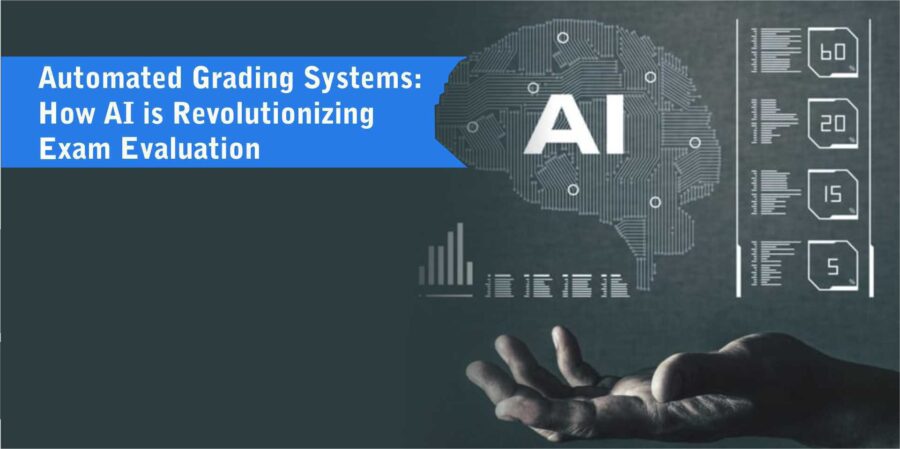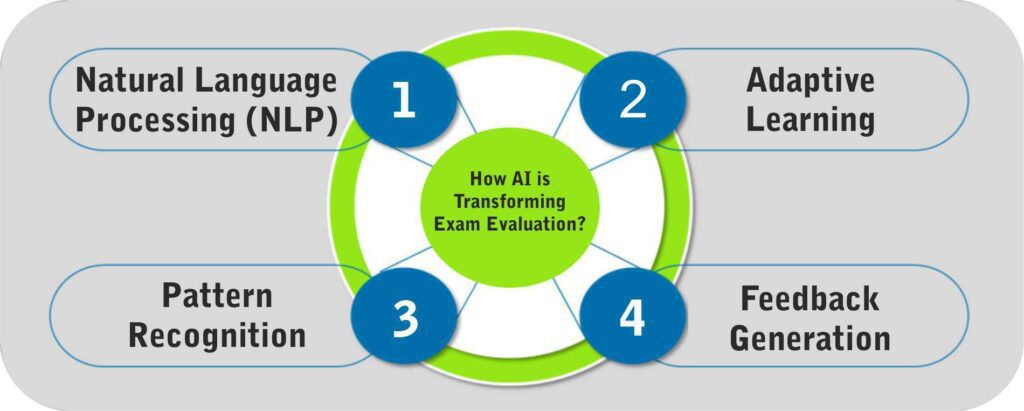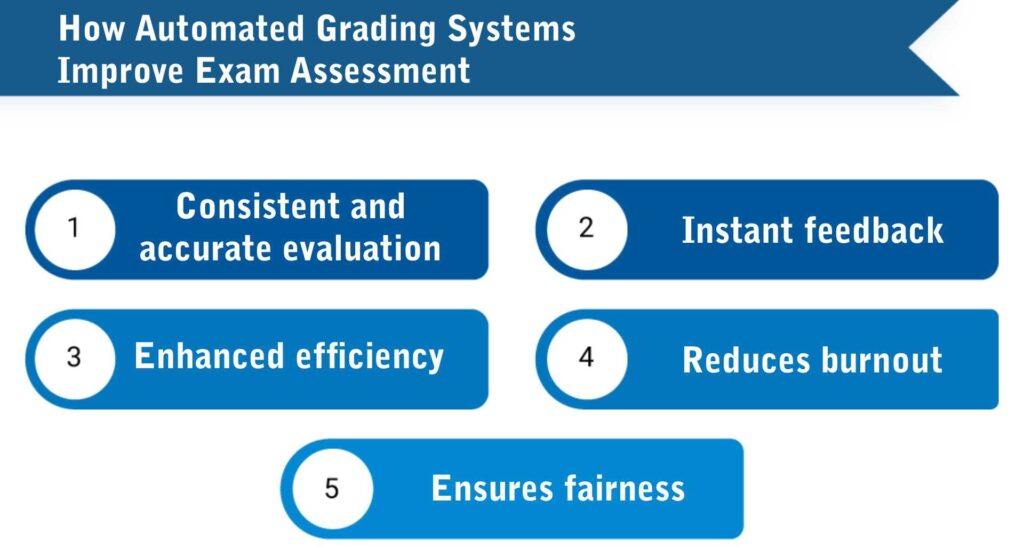
As technology continues to advance rapidly, the realm of education is not immune to its transformative effects. One area that has seen significant progress is exam evaluation. Traditionally, grading exams has been a time-consuming and subjective process, prone to human error and bias. However, with the emergence of automated grading systems powered by Artificial Intelligence (AI), the landscape of exam evaluation is undergoing a revolutionary change. In this blog post, we will explore the benefits of automated grading systems, discuss how AI is transforming exam evaluation, and highlight the role of AI courses offered by Great Learning in shaping this revolutionary field.
The Benefits of Automated Grading Systems
Automated grading systems bring a host of advantages to the process of exam evaluation. Here are a few key benefits:
Efficiency:
Manual grading exams can be labor-intensive, especially in large educational institutions. Automated grading systems significantly reduce the time and effort required to evaluate exams, enabling teachers and professors to focus on other critical aspects of education, such as lesson planning and personalized student feedback.
Consistency:
Human graders may introduce inconsistencies in their evaluation due to fatigue, personal biases, or varying interpretations of grading rubrics. Automated grading systems, on the other hand, follow a predefined set of rules and standards consistently, ensuring fair and objective evaluations for all students.
Speed:
With AI-powered grading systems, exams can be evaluated and results generated in a fraction of the time it would take manually. This not only benefits students by providing timely feedback but also allows educational institutions to streamline their administrative processes.
Scalability:
As educational institutions continue to grow, the demand for efficient grading systems increases. Automated grading systems can easily handle many exams, making them highly scalable solutions that can adapt to changing educational needs.
How AI is Transforming Exam Evaluation?

Artificial Intelligence plays a vital role in revolutionizing exam evaluation through automated grading systems. Here are some ways in which AI technology is transforming this field:
Natural Language Processing (NLP):
NLP algorithms enable automated grading systems to analyze and understand written responses. By employing machine learning techniques, AI can assess the quality, coherence, and relevance of the student’s answers, providing valuable insights into their understanding of the subject matter.
Pattern Recognition:
AI-powered systems can recognize patterns in student responses and identify common errors or misconceptions. This allows educators to pinpoint areas where students may be struggling and tailor their teaching strategies accordingly.
Adaptive Learning:
AI-based grading systems, empowered by the knowledge and techniques acquired through an artificial intelligence course, can adapt and improve over time. By analyzing vast amounts of student data, these systems can identify areas of weakness and develop personalized feedback and recommendations for individual learners. This personalized approach enhances the learning experience and helps students progress at their own pace.
Feedback Generation:
AI algorithms can generate detailed feedback for students, highlighting their strengths and improvement areas. This feedback not only guides students but also saves educators’ time by automating the process of generating individualized feedback.
Accuracy and Efficiency: How Automated Grading Systems Improve Exam Assessment

Automated grading systems powered by artificial intelligence (AI) have revolutionized the exam evaluation process, increasing accuracy and efficiency. Traditional manual grading methods are time-consuming and susceptible to human errors and subjectivity. In contrast, automated grading systems offer a reliable and objective approach to assessing exams.
- Consistent and accurate evaluation: AI algorithms can recognize patterns and evaluate responses based on predefined criteria, ensuring consistent and impartial grading.
- Instant feedback: Automated grading systems provide students with immediate feedback, allowing them to promptly understand their mistakes and areas for improvement.
- Enhanced efficiency: Automated systems can process exams at a faster pace than manual grading, reducing the workload on educators and freeing up their time for other important tasks.
- Reduces burnout: By automating the grading process, educators are relieved from the daunting task of evaluating a large number of exams within a limited timeframe, reducing the risk of burnout.
- Ensures fairness: Automated grading eliminates subjective biases that can arise from human grading, promoting fairness in the assessment process.
Overcoming Challenges: Implementing Automated Grading Systems in Educational Institutions
The implementation of automated grading systems in educational institutions presents various challenges that need to be addressed for successful integration. While these systems offer numerous benefits, their adoption requires careful planning, collaboration, and overcoming certain hurdles.
- Compatibility with existing assessment practices and infrastructure: Ensuring that automated grading systems align with established evaluation methods, grading scales, and software systems may require modifications or adaptations. Collaborative efforts between administrators, educators, and technology experts are crucial in addressing this challenge.
- Training and familiarization of teachers: Educators need to understand how automated grading systems work, their limitations, and how to interpret and utilize the generated results effectively. Professional development programs and training workshops can equip teachers with the necessary skills and knowledge for incorporating automated grading systems into their teaching practices.
- Privacy and data security: Protecting student data and complying with privacy regulations are essential considerations. Implementing robust security measures, obtaining consent from students and parents, and transparently communicating data handling practices are necessary steps to address privacy and data security concerns.
The Role of Teachers in an AI-Driven Grading Environment
As automated grading systems powered by artificial intelligence (AI) become more prevalent in educational institutions, the role of teachers in an AI-driven grading environment evolves and expands. While these systems handle the bulk of exam evaluation, the importance of teachers in providing guidance, support, and context remains crucial for holistic student development.
- Setting assessment criteria and standards: Teachers define the rubrics and guidelines used by automated grading systems, ensuring alignment with educational objectives and desired learning outcomes.
- Interpreting and analyzing results: Teachers bring a human touch by understanding the context of student responses and providing nuanced feedback. They can identify patterns, offer individualized support, and guide students based on their strengths, weaknesses, and learning styles.
- Personalized guidance and support: Teachers act as mentors and motivators, providing emotional support and encouragement to students. They foster a positive learning environment, inspire critical thinking, and cultivate a growth mindset. Teachers can also identify students who may require additional assistance and provide tailored support.
- Going beyond automated grading: Teachers offer support and interventions that extend beyond the scope of automated grading systems. They provide personalized attention, address individual student needs, and offer academic and personal development guidance.
Conclusion
Automated grading systems powered by Artificial Intelligence are transforming the way exams are evaluated. With their efficiency, consistency, speed, and scalability, these systems offer numerous benefits to both educators and students. AI technology, including natural language processing, pattern recognition, and adaptive learning, plays a pivotal role in revolutionizing exam evaluation. Artificial Intelligence courses provide learners with the necessary skills and expertise to thrive in this field and contribute to the advancement of automated grading systems. By leveraging the knowledge gained from MIT’s AI course, learners can become catalysts for change in education, applying cutting-edge AI techniques to enhance exam evaluation methods. Embracing the potential of AI in exam evaluation will undoubtedly lead to a more efficient, accurate, and personalized learning experience for students worldwide.